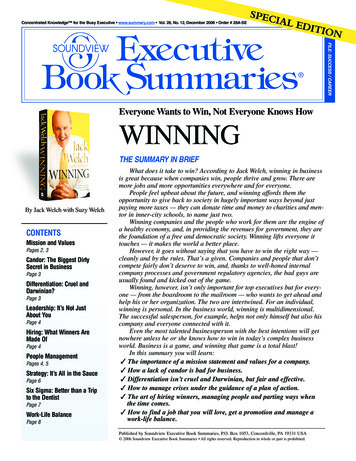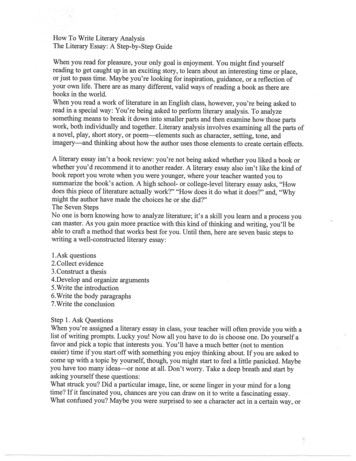
Transcription
How to WriteAWinning Business PlanSmall Business Development CenterValdosta State University100 Thaxton HallValdosta, GA 31698-0077229.245.3738 Voice229.245.3741 Facsimilewww.valdosta.edu/sbdc
ForewordThis business plan workbook has been developed bythe staff of the Valdosta State University SmallBusiness Development Center. It is intended to guidebusiness owners through the process of creating abusiness plan, and may not provide information oneverything that should be included in your plan.Each business plan is different, based upon the needsof the owners and/or the intended readers of the plan.Further information on specific items, research, orfinancial processes can be obtained from the SmallBusiness Development Center nearest you.For more information, visit us on the Internet atwww.valdosta.edu/sbdcorwww.sbdc.uga.eduRevised December 2003
Table of ContentsWhat is a business plan and why should your write one?1Research and outline3The executive summary or introduction4The market8The competition11The location12The management14Personnel16Application and expected effect of the loan18Sources and uses of funds20Estimated personal and living expenses21Estimated cash needed to start a business22Financial statements23Cash flow worksheet26Income statement worksheet27Balance sheet worksheet28Supporting documents29Personal financial statement30Business terms and definitions32
What Is a Business Plan, and Why Should You Write One?A business plan is essentially a map to your targeted destination. Ideally, it gets you fromyour starting point to your goal: form the basic business concept to a healthy, successfulbusiness. It gives you a clear idea of the obstacles that may lie ahead, and points outalternate routes.Business planning is not only a chore, but also an opportunity. While creating yourbusiness plan, you may have the chance to:1.2.3.4.Learn about your industryLearn about your marketGain control over your businessObtain a competitive edgeA business plan is a written document that describes you will run your business. Itcovers, at a bare minimum, the seven basic areas of business:1.2.3.4.5.6.7.Product eManagementIn each of these areas, your business plan will describe: The results you want to achieve The criteria you will use to evaluate the resultsThe activities that must be done to achieve themThe resources required to perform these activitiesMoneyPeopleTimeEquipmentThe reasons that you believe the plan will succeed.A Good Business Plan Can Take You to the TopA good business plan for a sound business concept helps you achieve your goals. It savesyou time and money by focusing on your activities. No other endeavor will propel you asfar forward in your enterprise as building your business plan. The process is challenging,creative, and rewarding. It may even be fun!
Almost everyone knows that you should write a business plan, but very few actually go tothe trouble of doing so. There are a number of reasons why you should write yourbusiness plan.1.2.3.4.First, it is absolutely necessary that you provide a business plan to anyprospective lender. The completed business plan communicates yourideas to others and provides the basis for your financing proposal.The process of putting a business plan together forces you to take anobjective, critical, unemotional look at your business project in its entirety.To this end, it is quite helpful in preventing you from making a costlymistake.The finished product-your business plan-is an operating tool that, ifproperly used, will help you manage your business and work effectivelytowards its success.The business planning process often helps partners, spouses, or othersholding a vested interest in the business understand the project more fully.This will enable stakeholders to iron out any differences before theybecome major problems.The importance of planning cannot be over-stressed. By taking an objective look at yourbusiness, you can identify areas of weakness and strength, pinpoint needs you mightotherwise overlook, spot opportunities early, and begin planning how to best achieveyour business goals.Your business plan help you avoid going into a business venture that is doomed tofailure. If your proposed venture is marginal, the business plan will help show you whyand may help you avoid paying the high price of failure.Finally, the business plan provides the information needed by others to evaluate yourventure. A thorough business plan quickly becomes a complete financing proposal thatwill meet the requirement of most lenders. No matter who the intended reader is, yourbusiness plan will help all interested parties understand fully and evaluate your businessin a more thorough and comprehensive manner.Must a Business Plan Be Written?Certainly, you have successfully planned things in the past without writing them down.However, it is a fact of human nature that we take things more seriously when we committhem to paper. It is pretty difficult to remember your business ideas from three monthsago when you are up to your ears in today’s business problems. From a practicalstandpoint, you will not be considered for financing from a banker or most other fundingsources without a written business plan.Why should you expect anything less from yourself than what your banker expects fromyou?
Doing the ResearchYou will need to do research in order to prepare your business plan. The better and morecomprehensive your research, the more likely your assumptions and projections will berealistic. Listed below are a few suggested research resources:Public librariesChambers of CommerceColleges or universitiesCompetitors or similar businessesCustomers or potential customersVendors or suppliersTrade associationsBusiness Plan OutlineA business plan generally has three parts: A narrative section, a financial section, and asupporting documents section. Not every plan will always look the same, but most willcontain these three parts, at a minimum.The Narrative1.2.3.4.5.6.The introduction or executive summaryThe marketThe competitionThe locationThe managementThe personnelThe Financial Data1.2.3.4.5.6.7.8.Sources and uses of fundsAssumptionsPro-forma cash flow statementsPro-forma balance sheetsPro-forma income statementsBreak-even analysisCollateral listingInterim financial statements and historical statements (if an existingbusiness.)Supporting Documents1.2.3.ResumesPersonal financial statementsReferences
4.5.6.7.8.9.Letters of intentCredit reports and letter of explanation (if you have significant derogatorycredit.)Job descriptionsWritten cost estimates for capital expendituresIncome tax returnsMarket researchThe NarrativeExecutive Summary or IntroductionThis is a very important section of the business plan, and is generally one of the mostdifficult sections to write. It describes your business (or concept), introduces the businessplan, and defines the reasons for writing the plan. It is quite often the only portion of thebusiness plan that a lender’s committee may read, particularly if your loan officer ispresenting the loan request to a bank’s board. It is your first opportunity to shine, grabthe reader’s attention, and try to generate interest in your project.If you cannot describe your business clearly and simply in one ortwo pages, then you have not done enough research and work.Remember that the technical support for your business will be found primarily in thefinancial data and supporting documentation. In the narrative section, refer to thesupporting documentation as necessary. Sometimes, less is more, and too much detailmay get in the way of explaining your idea and will confuse your audience.The executive summary or introduction should ideally be the LAST section that youwrite, even though it appears first in your business plan. The reason for this is that youwant to be sure that you have covered all the sections, done all your research, and fullyunderstand what you are trying to communicate.Generally, you want to explain the following:1.What the business is (or will be).2.What market you intend or expect to service, the size of the market, and yourexpected market share.
3.Why you can serve that market better than your competition.4.Why you have chosen your particular location.5.What management and other personnel are required and available for theoperation.6.Why your investment or someone else’s investment (debt or equity) will makeyour business profitable.Questions you should try to answer:1.What type of business: retail, wholesale, manufacturing, or service?2.What is the nature of your product(s) or service(s)?3.What is the status of the business: start-up, expansion of on-going concern,purchase of an existing business?4.Business legal form: sole proprietorship, corporation, limited liability company,or partnership?
5.Who are the customers?6.Why is the business going to be profitable?7.When will (or did) your business open?8.What hours of the day and days of the week will you (or do you) operate?For a new business:1.Why will you be successful in this business?2.What is your experience in this type of business?3.Have you spoke with other people in this type of business? What was theirresponse or recommendation to you?4.What will be special about your business?
5.Have you spoken to prospective trade suppliers? What technical and/ormanagerial help will they provide?6.Have you inquired about trade credit? What was the response?7.If you will be doing any contract work, what are the credit terms? (Reference anyfirm contract and include it as a supporting document.)8.Do you have any letters of intent from any prospective suppliers or purchasers?(Reference and include as a supporting document.)For a business purchase:1.When, where, and by whom was the company founded?2.Why is the owner selling the business?3.How did you arrive at a purchase price for the business?4.What is the trend for sales and profitability?5.If the business is going downhill, why? How will you turn it around?
6.How will your management team make the business more profitable?Answering these questions will help you form a written policy for your business. Theseare rules that you should not deviate from as you manage the business, unless you haveclear and compelling reasons.These questions will also help you formulate a mission statement. A mission statementhelps to establish direction and lends stability to your business. Direction and stabilityare as important to a business as to a tightrope walker. Therefore, you should give them agreat deal of thought and planning.The MarketThere are two important maxims to keep in mind for this section:1.2.Minimize opportunities for customer dissatisfaction.Marketing wars are never won-they are always lost.In this section, you will develop a marketing strategy, a plan within a plan. You willwant to make sure that you don’t lose the marketing war by making avoidable mistakes.Your business succeeds or fails according to how well you satisfy your customer’sperceptions, wants, and expectations. This means that you have no choice but to learnwho your customers or prospects are, why they buy from you or from someone else, andwhat you can do about getting more customers.You must be thoroughly knowledgeable about your market, the people who buy (or willbuy) your product or service. You need a stream of customers that will buy your goods,at a price that yields you a profit.Four basic marketing strategies:1.2.3.4.Sell old products to old customers. (least risky)Sell new products to old customers.Sell old products to new customers.Sell new products to new customers. (most risky.)
If you do not know who your customers are (or will be), there is no way to find out whatthey want. You cannot advertise effectively, you can’t develop products or services thatmeet their needs, and you cannot beat your competition.Segmenting and categorizing your customers and prospects makes sense, even for thesmallest businesses. It is a necessity for a business in a rapidly changing market wherethe experience-based “feel” for the customer is lacking or no longer applies. That “feel”is a poor substitute for segmentation, but it is better than nothing. Aided by segmentationand analysis, your sense of who the market is will become a powerful competitiveadvantage.Generally, explain who needs your product or service, and why.Questions you should try to answer:1.Who, exactly, is your market? Describe them with regards to their characteristicssuch as age, sex, race, profession, income, etc. Do this for each of your market segments.2.What is the present size (in units of product, or dollars if available) of the market?3.What percentage of the market will you have?4.What is the market’s growth potential?5.As the market grows, will your share increase or decrease?6.How are you going to satisfy your market?
7.How will you attract and keep this market?8.How can you expand your market?9.How are you going to price your service or product to make a profit while beingcompetitive?10.What price do you anticipate getting for your product?11.Is the price competitive?12.What evidence do you have that the customer will pay your price?13.How did you arrive at your price? Is it profitable?14.Do you offer any special advantages that may justify a higher price? (You do nothave to engage in direct price competition.)15.Will you offer credit to your customers? If so, is this really necessary? Can youafford to extend credit? Can you afford bad debts?
The CompetitionWho are your competitors? Look for companies that are selling the same or similarproducts, or chasing the same or similar customers.You can learn a lot from your competitors:What do they do better that you?Less well than you?How do they please their customers?What are their pricing policies?Where and how do they advertise? Does it work?Your suppliers should have information about what your competitors are doing and whatnon-competitors in your line of business are doing elsewhere (another city or state, forexample.) Take a trip and visit a non-competitor in your industry. (Make sure that youmake an appointment first.) Small business owners love to talk about their business ifyou aren’t a competitor, you make an appointment in advance, and you let them knowbeforehand what you are going to ask. You may actually find a wonderful mentor thisway!Information is power. Most small business owners do not actually take the time to collector analyze competitor information. There is nothing wrong, immoral, or illegal aboutchecking out the competition. Athletes and armies do it all the time, and so should you!Questions you should answer:1.Who are your five nearest competitors? List them by name.2.How will your business operation be better than theirs?
3.How is their business? Is it steady, increasing, or decreasing? Why?4.How are their operations similar or dissimilar from yours?5.What are their strengths and weaknesses?6.What have you learned from watching their operations?7.How will you keep an eye on the competition in the future?LocationProper site location can help your business make money. If you are going into business,try to locate the ideal site, then figure out how close you can come to it.Don’t go into business in any given spot just because the price is low. Market forcesgenerally fix rent and purchase prices, and a low price usually reflects low desirability.For some operations, this may not matter, particularly if your business is a destination.However, for others, the three most important factors in real estate are location, location,and location.
Once you get started, or if you are already in a good location, keep your eye on changesin your general vicinity. New roads, population changes, and zoning issues can alladversely impact your business. Also, it is a good idea to keep in touch with a real estateprofessional. It is their business to know what is happening in the marketplace.Questions you should answer:1.What is your business address or proposed address?2.What are the physical features of your building?3.Is your building leased or owned? What are the terms of the transaction?4.If renovations are needed, what are they and what are the expected costs? Getquotes, in writing, from more than one contractor, and include them in the supportingdocuments.5.What is the neighborhood or district like? Is it stabile, changing, improving, ordeteriorating?6.Do zoning regulations permit your type of business? (Check with the municipaloffices to be sure. It is not enough to take the realtor or owner’s word for it.)7.What kind of businesses are currently in the area?
8.Have you considered other areas? Why is this the one most desirable location foryour business?9.How does this location affect your operating costs?ManagementThe way you prepare the management section of your business plan depends on whetherit is being written for internal use or submission to investors or lenders.If your business plan is for internal use, emphasize managerial and operational aspectssuch as structure, style, and personnel issues. If you are preparing the business plan forlender review, focus primarily on the managerial backgrounds of your management team.These summaries should be written in an objective style, and should be relatively brief.You are not writing a resume, although you will include resumes in the supportingdocuments section.Management is the key to success for a business. It takes capable people, withappropriate abilities and experience, to develop a structure and style that well uses thepersonnel and financial resources of the business. That is the primary reason thatinvestors or lenders will carefully scrutinize and verify the backgrounds of yourmanagement team.Questions that you should answer:1.What is your business background?2.What management experience have you had?
3.What education have you had (both formal and informal learning experiences)that have a bearing on your managerial abilities?4.Personal data: age, where you live and have lived, special activities and interests,reasons for going into business, etc.5.Are you physically suited to the job? (Stamina is important.)6.Why are you going to be successful in this venture?7.Do you have direct operational experience in this type of venture?8.Do you have managerial experience in this type of business?9.Do you have managerial experience acquired elsewhere, such as a different typeof business, in civic activities, educational activities, or social activities?10.Include the above information on ALL of your management team. Attachadditional pages if necessary.
11.Who does what? Who reports to whom? Who makes financial decisions?12.What will management be paid?13.What other outside resources are available? (Attorneys, CPA’s, consultants, etc.)Note: A personal financial statement MUST be included in the supporting documents ifyou are submitting your business plan as a financing proposal.PersonnelPersonnel management is an area that most people think they can do by themselves, butfew people actually do well. It doesn’t take a human relations expert to place a classifiedadvertisement in the newspaper, talk to the people who send resumes, and tell someonehe or she is hired. The trick is to hire someone who will do the job efficiently,effectively, and have them like the job well enough to stay.The impact of hiring a bad employee cannot be overstated. It causes financial hardship,poor morale, bad service, and stress!The best thing you can do to develop a productive, quality work environment is tocontinually educate yourself in the areas of personnel and human relations management.Go to workshops and seminars to stay current on how to develop and maintain aproductive staff. Make sure you know all the federal, state, and local laws and taxregulations pertaining to hiring, firing, and maintaining employee files.Personnel guidelines:Add employees only as they are needed.Hire the person with the right qualifications and characteristics for the job.Make sure that all of your employees know EXACTLY what is expected of them.Use a job description. (Include the job description in your supporting documents.)Allow for adequate training.Communicate with your employees openly and honestly.Make sure you meet all the legal and accounting requirements of havingemployees.
Use part-time employees or outside contracted labor when it is appropriate.Make sure that you know the law regarding whether you have an employee or anindependent contractor.When in doubt, secure appropriate professional counsel, such as an attorney orCPA.Questions that you should answer:1.What are your personnel needs now? In the near future? In five years?2.What skills must your employees have?3.Are the people you need available? If so, where can you find them?4.Will your employees be full-time or part-time?5.Will you pay hourly wages or salaries?6.Will you provide fringe benefits? If so, what? Have you calculated the cost ofthese fringe benefits?7.Will you utilize overtime?
8.Will you have to train people? If so, what will it cost the business?Application and Expected Effect of the LoanThis section describes what your funding will be used for. It describes how the moneywill be used, why it is a valuable use of the money, and how you will provide a return onthe investment. Even if you plan to finance the business yourself, it is sound businesspractice to know how well you money works for you.The objective of this is section is to give you and your funding partner a qualitativeinsight into the expected effect of the loan on the business, and to specify the details ofthe deal as a starting point for discussion between you and your funding source.Questions that you should answer:1.How much capital will your business require?2.How much is your personal investment? It is worth repeating that it is unlikelyyou will secure 100% financing from any reputable funding source.3.How is the loan or investment to be spent? (This can be fairly general, such asworking capital, new equipment, inventory, supplies, etc.)4.What is the specific model name and/or number of your purchase(s)?5.Who is the supplier?6.What is the price?
7.How much will you pay in sales tax, freight, installation charges, and any otherincidental fees?8.How will the loan or investment make your business more profitable?Use the spaces below to make any additional notes or to record any information notdirectly related to the questions in the previous sections.
Sources and Uses of FundsSources of FundsPersonal Equity InjectionOther Equity InjuectionBank LoanSBA Guaranteed LoanOtherTotal Sources of Funds Uses of ing CapitalReserve for ContingenciesOther Total Uses of Funds
Estimated Personal and Living ExpensesItem:Regular PaymentsRent or House PaymentProperty TaxesCar PaymentsFurniture/Appliance PaymentsLoan PaymentsCredit Card PaymentsHealth InsuranceOther InsuranceOtherExpense for Month Household ExpensesFood (Groceries)UtilitiesTelephoneCell PhoneWater/Sewer/SanitationElectricityGasCable or Satellite TelevisionInternet ServiceOtherPersonal ExpensesClothing & LaundryMedical, Dental, & DrugsEducationDues & SubscriptionsTithes or Other Charitable ContributionsGasoline & Automobile ExpenseTravel & EntertainmentLeisure & RecreationMiscellaneousChildcareOtherTotal Personal Expenses (Draw Required from Business)
Estimated Cash Needed to Start a BusinessInstructions: Gather your startup and operating costs as closely as possible. When possible,get quotations from vendors or suppliers. Multiply the first column of monthly operatingexpenses by the number of months you anticipate to be unprofitable. Add all the numberstogether to estimate your total cash needs. Your equity injection should equal approximatelytwenty percent of the total cash needed to start the business.Monthly (recurring) expenses:Salary/draw of owner/managerAll other salaries/wagesPayroll TaxesRent (building and equipment)AdvertisingOffice expensesSuppliesTelephone//fax/internetOther utilitiesInsuranceMaintenance and repairLegal & Professional FeesLoan principal & interestMiscellaneousInventory replenishmentTaxesOtherSubtotal:One-time start-up costs:Furniture, fixtures, equipmentInstallation of FFERemodeling/buildoutBeginning inventoryDeposits with utilities & othersLegal & professional feesLicenses & PermitsAdvertising & promotions for openingOtherSubtotal:Total Cash Needed to Start BusinessMonthly Extended
FinancialsJust as the narrative section of the business plan tells the story of your business, so doesthe financial section. The major difference is in the way the story is read, interpreted, andunderstood. While the banker may just read your narrative, you can rest assured that hewill actually analyze your financial statements.The first thing that the banker will look for in the pro-forma financial statements will beconsistency and clarity. He is looking to make sure that your logic is well grounded, andthat you are consistent across all financial statements and between the narrative sectionand financial statements. In other words, if your narrative says that you will sell a certainamount of product over a given period of time, then your financial statements shouldreflect the same information.There are certain financial statements that are required to be in your business plan. Thebanker must have this information to do a written credit analysis of your plan generallyrequired by all review and approving groups such as a loan committee or the US SmallBusiness Administration. For instance, he must have your income statement to compareyou to industry standards for profitability, expenses, and interest-coverage ratio. He musthave your balance sheet to determine whether you meet minimum equity requirements.The cash flow statement helps to assure that you are borrowing a sufficient sum of moneyso as to avoid bank overdrafts and cash flow discomforts.The Pro-forma Cash Flow StatementsWhen your banker is analyzing the business plan, he will need to see a projection of yourcash inflows and outflows each month for a two-year period of time. Cash flow isdefined as the movement of cash into and out of a business over a specific period of time.Cash may come from numerous sources. For instance, even before you start the business,you will likely have some money coming in. This money will likely include both equityinjections and debt infusions. In other words, as you prepare to open your doors for thefirst time, you have to have cash available to do all the things necessary to make yourbusiness ready. When you begin making sales, you may have cash coming in from cashsales, cash coming in from the collection of credit sales, and may still have equity anddebt infusions.As you prepare to open your business, you will certainly have cash outflows such asstartup expenses for inventory, remodeling, equipment, loan closing costs, deposits, etc.These cash outflows may not necessarily be counted as expenses to the business in thefirst accounting period. Therefore, it is necessary to reconcile the changes in the cashbalances back to the business profit or loss.
The Pro-forma Income StatementsThe pro-forma income statement is the instrument by which you reconcile those changesin cash balances. Some of your cash inflows are not reflected at all on your profit andloss, or income, statement.For instance, your equity infusions into or withdrawals from the business never count asincome or expenses. You are simply making a deposit into or withdrawal from the firm’schecking or savings account. Additionally, principal payments on the debt never count asan expense for the business. Since we don’t count the loan proceeds as business income,likewise we cannot count the loan principle repayment as a business expense. We will,however, count the interest expense.Additionally, many of your early cash outflows may be for capital items that last forlonger then the current accounting period. In other words, if you buy a computer, it isgenerally expected to last longer than a year. Therefore, you will write the cost of thecomputer off over time. This process is called depreciation, and depreciation is countedon the income statement, even though it is a non-cash expense. There may be other cashoutflows that do not count as an expense, or other non-cash expenses that count,according to your situation.The Balance SheetThe balance sheet is the glue that holds all the other financial statements together. It listseverything that you owe, and everything that you own, and keeps track of those itemsover time. “Everything that you own” is classified on the balance sheet as assets, while“everything that you owe” is classified as liabilities.Since those two amounts are seldom exactly equal to each other, we have anotherclassification on the balance sheet called equity. Equities may include money that youpay into the business, capital stock that you purchase to represent your share ofownership in the business, and earnings from the current or previous accounting periods.Again, what you have on your balance sheet will vary according to your situation andyour legal structure.The Breakeven AnalysisOne of the lesser-known and emphasized financial statements is the breakeven analysis.It is unlikely that your banker will request that you provide a breakeven analysis, but it isstill a highly useful tool for your business. It will assist you in answering questions suchas:What must my sales be before I begin making a profit?What will happen to my profit if my sales projections fall short?What will happen to my profit if I increase or decrease my prices?What will happen to my profit if I increase or decrease my expenses?
Your breakeven analysis will assist you in determining the point at which you incurneither profit nor loss-in other words, you
This business plan workbook has been developed by the staff of the Valdosta State University Small Business Development Center. It is intended to guide business owners through the process of creating a business plan, and may not provide information on everythi











